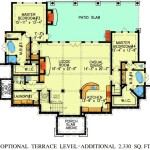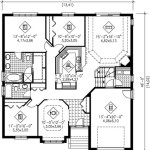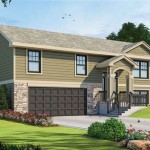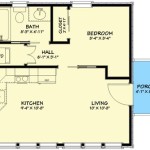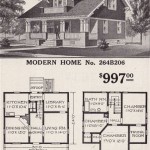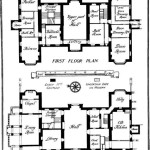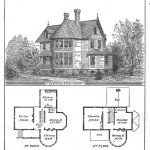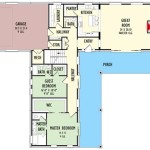Home Floor Plans With RV Garage: A Comprehensive Guide
The demand for home floor plans incorporating RV garages has steadily increased as recreational vehicles become more prevalent. This trend reflects a desire for convenient storage, maintenance, and accessibility to RVs, turning homes into functional bases for travel enthusiasts. These floor plans represent a significant investment and require careful consideration of various factors to ensure they meet the specific needs and preferences of the homeowner.
This article provides a comprehensive overview of home floor plans with RV garages, addressing key considerations related to design, functionality, and potential benefits. Understanding these aspects is essential for making informed decisions when choosing or customizing a home plan that integrates RV storage.
Understanding the Dimensions and Spatial Requirements
The primary factor influencing the design of a home floor plan with an RV garage is the size and type of recreational vehicle to be stored. RVs vary significantly in length, height, and width, necessitating careful measurement and planning. Failure to accurately assess these dimensions can lead to a garage that is inadequate for its intended purpose.
Standard RV garage dimensions generally start around 14 feet wide and 40 feet deep with a door height of at least 12 feet. However, larger RVs, particularly Class A motorhomes, may require garages that are 16 feet wide, 50 feet deep, or even larger, with door heights reaching 14 feet or more. The internal height of the garage is also crucial to consider, particularly for RVs with roof-mounted structures like air conditioning units.
Beyond the RV's overall dimensions, additional space is needed for maneuvering within the garage, performing maintenance tasks, and storing related equipment and supplies. A minimum of 2-3 feet of clearance around the RV is recommended for comfortable access and movement. Furthermore, consider designating areas for storing cleaning supplies, tools, and spare parts.
Consideration must also be given to the garage door mechanism. Roll-up doors are the most common choice for RV garages, providing maximum vertical clearance. However, sectional doors and side-sliding doors are also options, depending on space constraints and aesthetic preferences. The chosen door must be durable, weather-resistant, and equipped with reliable safety features.
The garage's foundation and structural integrity must be designed to support the weight of the RV and withstand the forces of wind and weather. Reinforced concrete slabs are typically used, and the framing should be robust enough to accommodate the large door opening and any potential snow loads. Proper insulation is also essential to maintain a comfortable temperature inside the garage and prevent condensation.
Integrating the RV Garage into the Overall Home Design
The integration of an RV garage into the overall home design requires careful planning to ensure both functionality and aesthetic appeal. The garage should complement the architectural style of the house and blend seamlessly with the surrounding landscape. Integrating the garage effectively involves considering its placement, orientation, and exterior finishes.
The location of the RV garage on the property is a critical decision. Ideally, it should be situated on a flat, easily accessible area with minimal grading or excavation required. The driveway leading to the garage should be wide and long enough to accommodate the RV's turning radius, preventing maneuvering difficulties. The orientation of the garage should also be considered in relation to sun exposure and prevailing winds.
Aesthetically, the RV garage should complement the architectural style of the main house. This can be achieved by using similar exterior materials, colors, and rooflines. Adding windows, doors, and decorative trim can further enhance the garage's visual appeal and integrate it into the overall design. Landscaping around the garage can also help to soften its appearance and blend it into the surroundings.
Internal access from the house to the RV garage is a desirable feature, providing convenient entry and exit without having to go outdoors. However, fire safety regulations typically require a fire-rated door and wall separating the garage from the living areas. This barrier helps to prevent the spread of fire and smoke in the event of an emergency.
Consider the potential for using the RV garage as a multi-purpose space. In addition to RV storage, it can be used as a workshop, hobby room, or storage area for other vehicles and equipment. Incorporating additional features like workbenches, storage cabinets, and electrical outlets can enhance its versatility. Adequate lighting is also essential for performing tasks inside the garage.
When designing a home with an RV garage, it's important to consider the long-term resale value. A well-designed and functional RV garage can be a significant selling point, particularly in areas with a high concentration of RV enthusiasts. Therefore, investing in quality materials, construction, and design can ultimately pay off in the future.
Essential Features and Considerations for Functionality
Beyond the basic dimensions and aesthetic integration, several essential features contribute to the functionality and usability of an RV garage. These features relate to power, plumbing, ventilation, and access, ensuring the garage is well-equipped to handle the needs of the RV and its owner.
Electrical power is crucial for operating RV appliances, charging batteries, and using power tools. A dedicated 50-amp electrical outlet is typically required to accommodate the power demands of most RVs. Additional 110-volt outlets should be strategically placed throughout the garage for convenience. Consider installing a subpanel to provide adequate power distribution and prevent overloading the main electrical panel.
Plumbing is another important consideration, particularly if the RV is to be used frequently. A water hookup allows for easy filling of the RV's water tank and cleaning of the exterior. A utility sink can also be useful for washing hands, cleaning equipment, and disposing of dirty water. If sewer hookups are desired, it's important to comply with local regulations and ensure proper drainage and sanitation.
Adequate ventilation is essential to prevent the buildup of fumes, moisture, and odors inside the garage. Installing exhaust fans, vents, or a whole-house ventilation system can help to maintain air quality and prevent the growth of mold and mildew. Consider using a dehumidifier in humid climates to control moisture levels.
Access to the RV garage should be convenient and secure. A wide driveway, adequate lighting, and a reliable garage door opener are essential for easy entry and exit. Security features like motion sensors, security cameras, and reinforced doors can deter theft and protect the RV and its contents. Consider installing a keypad entry system for keyless access.
The interior of the RV garage should be designed for easy maintenance and cleaning. Durable flooring materials like epoxy or sealed concrete are resistant to stains, spills, and damage. Walls should be easy to clean and repaint, and the interior should be free of obstructions. Regularly cleaning and organizing the garage can help to prevent clutter and maintain its functionality.
Consider the potential for future expansion of the RV garage. If there is a possibility of upgrading to a larger RV or adding additional storage space, it's wise to plan for this in advance. Leaving room for expansion can save time and money in the long run. This could involve designing the garage with extra height or width, or positioning it in a location that allows for easy addition.
Finally, it is important to consult with qualified professionals, including architects, engineers, and contractors, when designing and building a home with an RV garage. These professionals can provide valuable expertise on structural design, building codes, and construction techniques. Obtaining the necessary permits and complying with all applicable regulations is essential to ensure a safe and compliant structure.

Storage Solutions Rv Garage Plans And More Houseplans Blog Com

Viejo 2 Car With Rv Option Dbu Homes

Storage Solutions Rv Garage Plans And More Houseplans Blog Com

Brand New Home With Rv Garage Cool Floorplan Single Story House Floor Plans Craftsman

Sunset Harbor Ii Floorplan Garage House Plans Small Floor

Mesquite Double Rv Garage Model House Plans Barndominium Floor Barn Homes

Storage Solutions Rv Garage Plans And More Houseplans Blog Com

Nrflkgf Gif 450 Pixels Garage Apartment Floor Plans

Grand Elizabeth Rv Single Floor Plans Palmer Alaska Custom Homes Robert Yundt

Mesquite Double Rv Garage Model House Plans Floor Apartment

